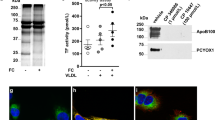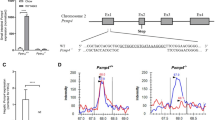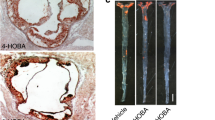Abstract
Serum paraoxonase (PON1) is an esterase that is associated with high-density lipoproteins (HDLs) in the plasma; it is involved in the detoxification of organophosphate insecticides such as parathion and chlorpyrifos1,2,3. PON1 may also confer protection against coronary artery disease by destroying pro-inflammatory oxidized lipids present in oxidized low-density lipoproteins (LDLs)4,5,6,7,8. To study the role of PON1 in vivo, we created PON1 -knockout mice by gene targeting. Compared with their wild-type littermates, PON1-deficient mice were extremely sensitive to the toxic effects of chlorpyrifos oxon, the activated form of chlorpyrifos, and were more sensitive to chlorpyrifos itself. HDLs isolated from PON1-deficient mice were unable to prevent LDL oxidation in a co-cultured cell model of the artery wall, and both HDLs and LDLs isolated from PON1 -knockout mice were more susceptible to oxidation by co-cultured cells than the lipoproteins from wild-type littermates. When fed on a high-fat, high-cholesterol diet, PON1 -null mice were more susceptible to atherosclerosis than their wild-type littermates.
This is a preview of subscription content, access via your institution
Access options
Subscribe to this journal
Receive 51 print issues and online access
$199.00 per year
only $3.90 per issue
Buy this article
- Purchase on Springer Link
- Instant access to full article PDF
Prices may be subject to local taxes which are calculated during checkout



Similar content being viewed by others
References
Murphy, S. D. in Toxicology: The Basic Science of Poisons(eds Doull, J., Klassen, C. & Amdur, M.) 357–408 (Macmillan, New York, (1980)).
Tafuri, J. & Roberts, J. Organophosphate poisoning. Ann. Emerg. Med. 16, 193–202 (1987).
Smolen, A., Eckerson, H. W., Gan, K. N., Hailat, N. & La Du, B. N. Characteristics of the genetically determined allozymic forms of human serum paraoxonase/arylesterase. Drug Metab. Dispos. 19, 107–112 (1991).
Mackness, M. I., Arrol, S. & Durrington, P. N. Paraoxonase prevents accumulation of lipoperoxides in low-density lipoprotein. FEBS Lett. 286, 152–154 (1991).
Watson, A. D. et al. Protective effect of HDL associated paraoxonase-inhibition of the biological activity of minimally oxidized low density lipoprotein. J. Clin. Invest. 96, 2882–2891 (1995).
Shih, D. M. et al. Genetic-dietary regulation of serum paraoxonase expression and its role in atherogenesis in a mouse model. J. Clin. Invest. 97, 1630–1639 (1996).
Mackness, M. I., Mackness, B., Durrington, P. N., Connelly, P. W. & Hegele, R. A. Paraoxonase: biochemistry, genetics and relationship to plasma lipoproteins. Curr. Opin Lipidol. 7, 69–76 (1996).
Heinecke, J. W. & Lusis, A. J. Paraoxonase-gene polymorphisms associated with coronary heart disease: Support for the oxidative damage hypothesis? Am. J. Hum. Genet. 62, 20–24 ((1998)).
Costa, L. G. et al. Serum paraoxonase and its influence on paraoxon and chlorpyrifos-oxon toxicity in rats. Tox. Appl. Pharmac. 103, 66–76 (1990).
Li, W.-F., Costa, L. G. & Furlong, C. E. Serum paraoxonase status: a major factor in determining resistance to organophosphates. J. Tox. Envir. Hlth 40, 337–346 (1993).
Li, W.-F., Costa, L. G. & Furlong, C. E. Paraoxonase protects against chlorpyrifos toxicity in mice. Tox. Lett. 76, 219–226 (1995).
Humbert, R. et al. The molecular basis of the human serum paraoxonase activity polymorphism. Nature Genet. 3, 73–76 (1993).
Davies, H. G. et al. The effect of the human serum paraoxonase polymorphism is reversed with diazoxon, soman and sarin. Nature Genet. 14, 334–336 (1996).
Navab, M. et al. Monocyte transmigration induced by modification of low density lipoprotein in coculture of human aortic wall cells is due to induction of monocyte chemotactic protein 1 synthesis and is abolished by high density lipoprotein. J. Clin. Invest. 88, 2039–2046 (1991).
Navab, M. et al. Mildly oxidized LDL induces an increased apolipoprotein J/paraoxonase ratio. J. Clin. Invest. 99, 2005–2019 (1997).
Watson, A. D. et al. Effect of platelet activating factor-acetylhydrolase on the formation and action of minimally oxidized low density lipoprotein. J. Clin. Invest. 95, 774–782 (1995).
Mehrabian, M. et al. Influence of the apoA-II gene locus on HDL levels and fatty streak development in mice. Arterioscler. Thromb. 13, 1–10 (1993).
Acknowledgements
This work was supported by an NIH grant (to A.J.L., A.M.F. and M.N.), an NIEHS grant (to C.E.F.) and an American Heart Association Grant-in-Aid awarded by Greater Los Angeles Affiliate (to D.M.S.). We thank H. Cheroutre and K. Williams of UCLA Transgenic Core Facility for blastocyst injections; W. R. Clark and K. M. Lyons for advice in gene targeting work; S. Charugundla for lipid assays; G. P. Hough for MCP-1 assay; and X.-P. Wang and Y.-S. Shi for aortic lesion analysis.
Author information
Authors and Affiliations
Corresponding author
Rights and permissions
About this article
Cite this article
Shih, D., Gu, L., Xia, YR. et al. Mice lacking serum paraoxonase are susceptible to organophosphate toxicity and atherosclerosis. Nature 394, 284–287 (1998). https://doi.org/10.1038/28406
Received:
Accepted:
Issue Date:
DOI: https://doi.org/10.1038/28406
This article is cited by
-
Engineering consortia by polymeric microbial swarmbots
Nature Communications (2022)
-
Shell Matrix Protein N38 of Pinctada fucata, Inducing Vaterite Formation, Extends the DING Protein to the Mollusca World
Marine Biotechnology (2022)
-
Cardiotoxicity of some pesticides and their amelioration
Environmental Science and Pollution Research (2021)
-
The pesticide chlorpyrifos promotes obesity by inhibiting diet-induced thermogenesis in brown adipose tissue
Nature Communications (2021)
-
Serial measurements of Paraoxonase-1 (PON-1) activity in horses with experimentally induced endotoxemia
BMC Veterinary Research (2020)
Comments
By submitting a comment you agree to abide by our Terms and Community Guidelines. If you find something abusive or that does not comply with our terms or guidelines please flag it as inappropriate.



